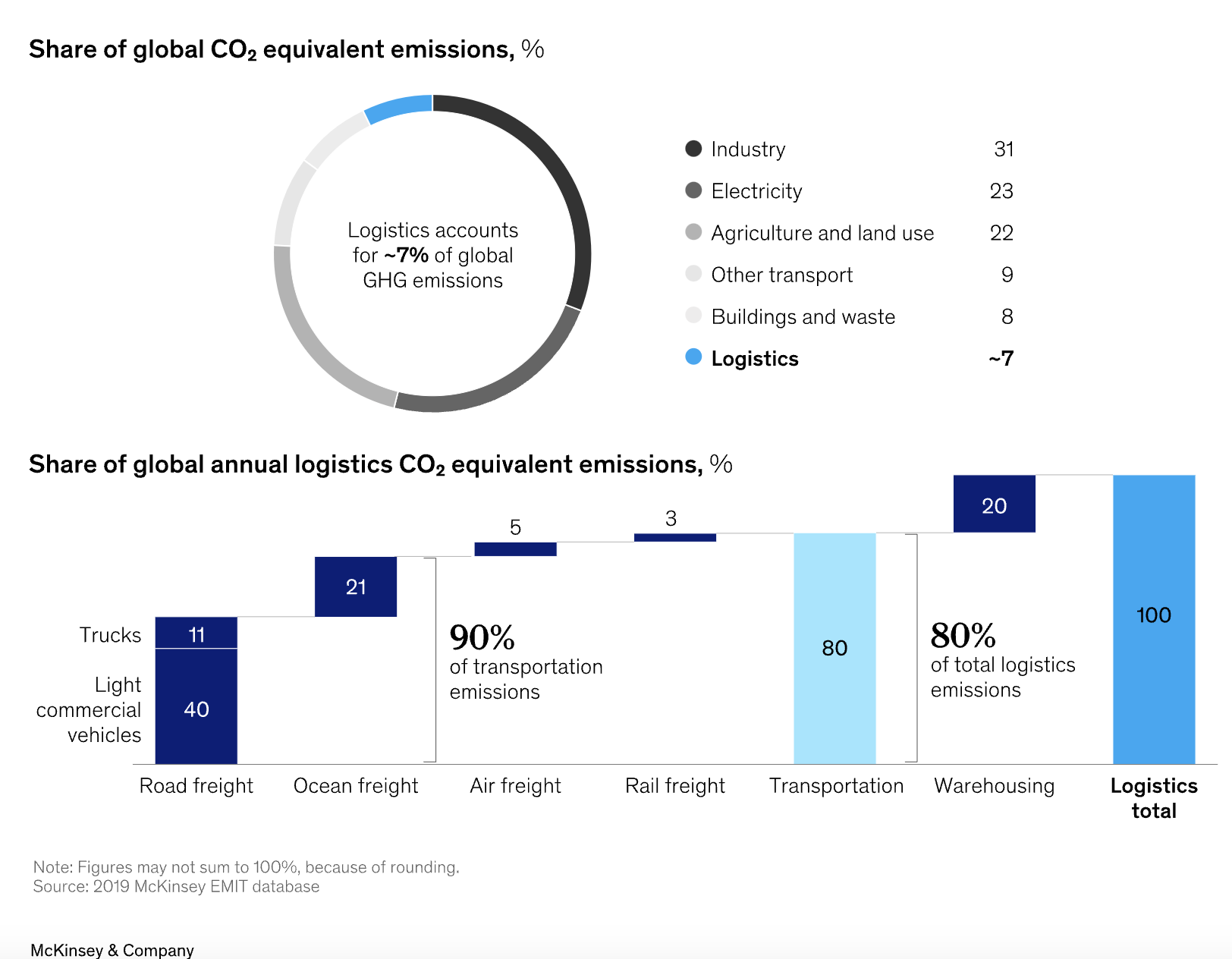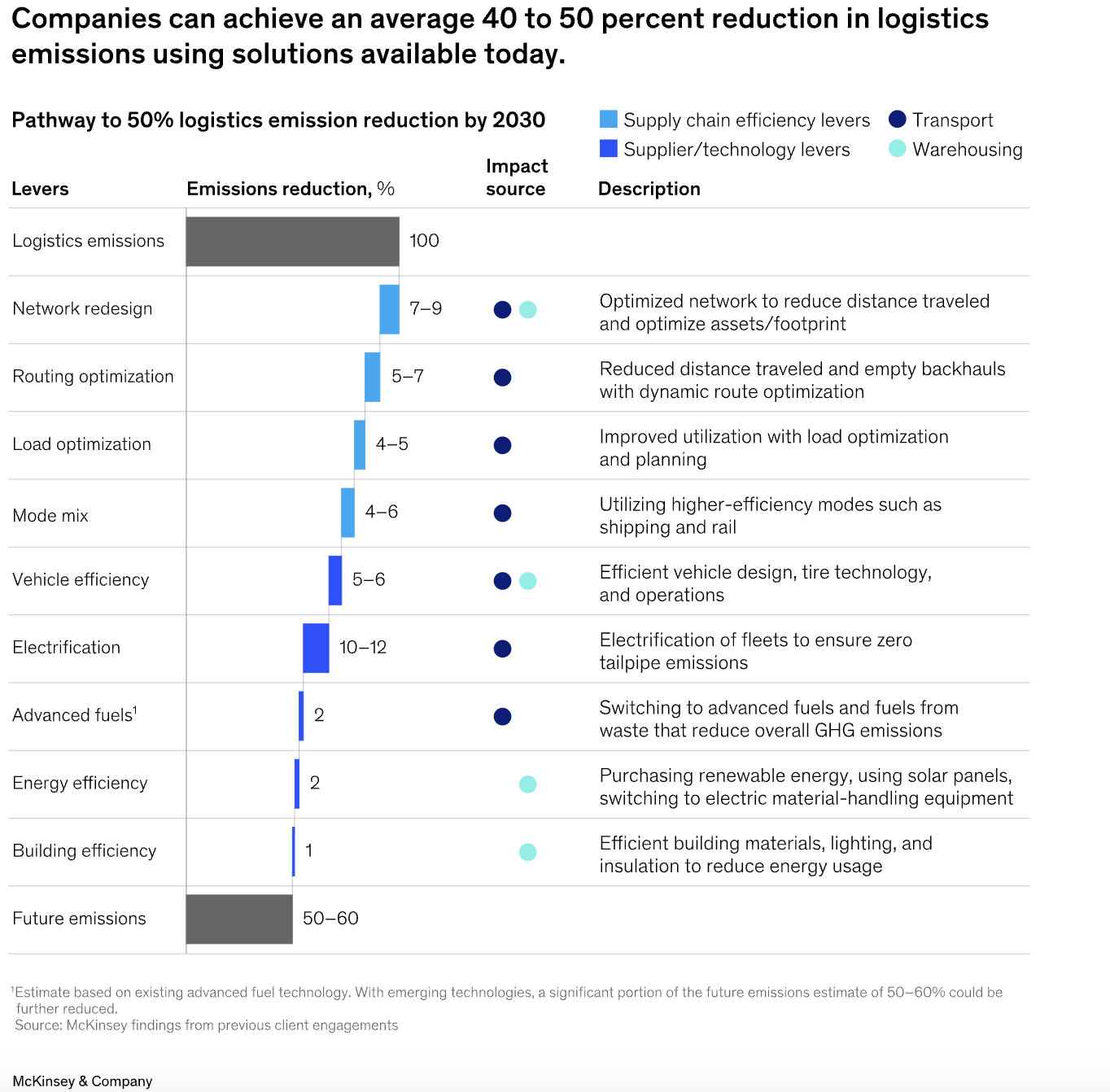Logistics emissions from freight and warehousing contribute to at least 7% of global greenhouse gas (GHG) emissions. Addressing these emissions is essential for any company aiming for net zero as part of a comprehensive environmental, social, and governance (ESG) strategy. McKinsey reports about it.

Market for green logistics
The focus on green logistics is expected to translate into significant financial implications in the coming years. According to McKinsey, demand for green logistics could reach an estimated $350 billion by 2030, representing about 15% of total global logistics expenditure, even without considering potential price premiums for green shipping.
Despite the promising future of green logistics, progress has been slow. Nearly half of the companies surveyed by McKinsey lack decarbonization goals. Only a quarter have set goals and believe they can achieve them, while a similar proportion doubt they can meet their carbon-reduction targets.
Currently, only about a quarter of global shippers and providers feel confident in their initiatives to meet decarbonization goals, indicating a gap between the willingness to pay for carbon-neutral shipping and actual implementation. As customer demands evolve, regulatory pressures increase, and stakeholder expectations rise, companies not decarbonize may fall behind competitors advancing their green initiatives.
Challenges
Several challenges hinder the decarbonization of logistics:
First-Mover Hesitancy: While shippers are willing to pay for low-carbon shipping and have set targets, the supply of high-quality, low-carbon shipping options is limited. Building this supply requires significant investment and new capabilities from carriers. Shippers are hesitant to commit financially to electric fleets due to uncertainties about operational viability and the availability of necessary infrastructure, such as commercial road charging.
Uncertain New Technologies: New decarbonization technologies come with challenges beyond cost, including disposal of residual assets, limitations on biofuel production capacity, and uncertainty about the total cost of ownership (TCO). Many companies are testing low-carbon technologies but are reluctant to scale up until greater certainty is achieved.
Sector and Company-Specific Considerations: Specific logistics use cases complicate planning for net-zero goals. For instance, US utility companies face state-level decarbonization policies and unique operational constraints, such as the need for vehicles to idle during hurricanes. The current charging infrastructure does not meet these needs.
Battery power is not a feasible solution in ocean shipping due to high energy demands. Sustainable fuels like methanol, ammonia, or liquefied hydrogen are necessary, but these technologies are not yet available at scale. For example, ammonia-powered engines and fuel cells for marine applications are still developing, and the supply of sustainable fuels at major ports is limited. These uncertainties delay investment decisions in new fleets.
Viable Routes to Decarbonization
Despite these challenges, viable routes to logistics decarbonization are emerging as technology solutions become more widespread and affordable. McKinsey’s analysis suggests that a 40-50% reduction in logistics emissions by 2030 is achievable with current technology.
In the short term, companies can employ proven, cost-effective decarbonization strategies. This starts with a holistic and analytical view of the supply chain to minimize distances traveled and improve emissions efficiency per mile.
Network Redesign: Reducing distances involves a data-driven understanding of warehouse and asset locations, relocation costs, demand forecasting, scenario planning, and operating costs. A decision model can evaluate costs and emissions to inform decisions on facility locations, manufacturing and warehousing footprints, make-versus-buy decisions, and customer allocation to optimal warehouse locations.
Warehouse Decarbonization: Warehouses can be decarbonized by reducing energy demands and aiming for emissions-neutral, self-sufficient operations with closed-loop systems. For instance, GLS operates a self-sufficient, emissions-free warehouse in Essen using photovoltaic and battery storage systems. Investments in energy-efficient fans, lighting, and temperature sensors, building envelope enhancements, on-site renewables, and electric equipment can significantly lower emissions and reduce operating costs.
Reducing Miles Traveled: Companies can combine load and routing improvements with optimized network locations to reduce unnecessary miles. Improved data-driven decisions can keep vehicles full and minimize “empty miles” where vehicles travel without cargo. Strategies like back-haul matching and multiday routing can reduce the need for a larger fleet.
Transport Mode Shifts: Shifting or mixing transport modes is an effective way to reduce costs and carbon emissions. Road freight is over five times more emissions-efficient than air freight, and rail and ocean shipping are seven to 20 times more efficient.
Steps to Decarbonization:
- Baseline Logistics Emissions and Set Targets: Assess current emissions and establish reduction goals.
- Establish Corporate Emissions Governance: Create a governance structure to oversee decarbonization efforts.
- Build and Execute a Decarbonization Portfolio: Develop and implement initial decarbonization initiatives through 2030.
- Monitor and Invest in Proven Technologies: Monitor new technologies and make targeted investments to stay on track with decarbonization goals.
Source: McKinsey






